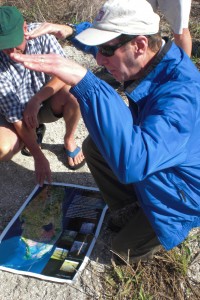The arbiter of the Everglades retires
By Courtney Robishaw
One could call Stuart Appelbaum the referee of the Florida Everglades.
Appelbaum helps play an important role in the day to day decisions of how much water everyone in South Florida is going to get as well as overseeing a plan that will take 30 years to implement and cost more than $13 billion to provide a more permanent fix to the Everglades.
Appelbaum is chief of the planning and policy division of the U.S. Army Corps of Engineers in Jacksonville and after 30 years he retires May 3.
“I’m comfortable with passing the baton on to others to take the next steps to restoration,” he said.
A native New Yorker, Appelbaum has an unobtrusive appearance that belies the power he has wielded. He received his bachelors of science from Polytechnic Institute of New York in civil engineering and his masters of science in water resources engineering from George Washington University.
Throughout his career, Appelbaum has tried to balance the different interests of the Everglades, including those of agriculture, flood control, development, water management and environmentalists.
“The Corps provides a lot of expertise where we have to reconcile and balance all these different interests, so obviously each interest is trying to maximize things to their advantage,” he said.
On a regular basis the Corps, along with advice from many different parties, decides how much water to flush out of the Everglades system to the oceans and how much to leave in the Everglades. It is a continual point of conflict.
Those in the agriculture district would like to see more water stored so that in the event of a drought, they can have a back-up water supply for their crops.
However, because of safety concerns for the dike surrounding Lake Okeechobee, water is stored at an optimal depth between 12 feet and 15 feet.
Conversely flood control interests want to keep water storage as low as possible.
“We’re trying to balance a variety of interests and we’re in the middle,” said Appelbaum.
The ultimate solution is to enlarge the amount of water available and increase water storage in the system. This would not only solve the interests of flood control managers and farmers, but it would enable the 6.5 million people who live around the borders of the Everglades in South Florida to have enough drinking water.
“We’re trying to enlarge the water pie, so we can store a lot more water in the natural system and the environment obviously needs a lot more water than it’s currently getting, so we can also provide water for agriculture and urban water supply,” Appelbaum said.
“The way to balance things is to enlarge the water pie and that allows all the different sectors to have a bigger piece of the pie,” he added.
But such efforts take years to accomplish.
One of Appelbaum’s first significant ecological projects was the restoration of the Kissimmee River. Originally a hundred-mile-long river, the Kissimmee had been broken up by a canal and the restoration project restored much of the natural flow of the river by removing two areas of canals. The Kissimmee project has won praise from many divergent groups.

Appelbaum oversaw the planning of many projects, including the Tamiami Bridge.-Photo by Purbita Saha
Appelbaum also oversaw the planning of the Everglades Skyway, a one-mile long elevated portion of the Tamiami Trail along U.S. Highway 41. The road had been cutting across the Everglades, essentially serving as a dam blocking the natural flow of water. The bridge allows water to travel underneath, restoring some of the original water flow.
While Appelbaum called the bridge “historic” toward hydrological connections, he added: “More of that will need to be done in the future.”
Appelbaum has also overseen management of the Herbert Hoover Dike, which surrounds Lake Okeechobee. Built in response to two destructive hurricanes in 1926 and 1928 in which close to 3,000 people lost their lives due to flooding, the dike is continually a management issue.
Currently, the Corps is rehabilitating the dike, because in 1930 when the Corps was first authorized to construct the dike, engineering was a lot less tolerant to risk than it is today. The foundation of the dike is very porous, especially when the lake reaches higher elevations.
“At 21 feet [the maximum depth of Lake Okeechobee], there is a 100 percent chance the dike would collapse,” said Appelbaum.
Appelbaum is sad to leave the Everglades restoration project, but he is optimistic about its future.
“Since this is something I started way back in the beginning, obviously there is some sadness with leaving with the job not being completed,” he said. “Because it is going to take 30 to 35 years, I’ve always recognized it was going to transcend me.”


